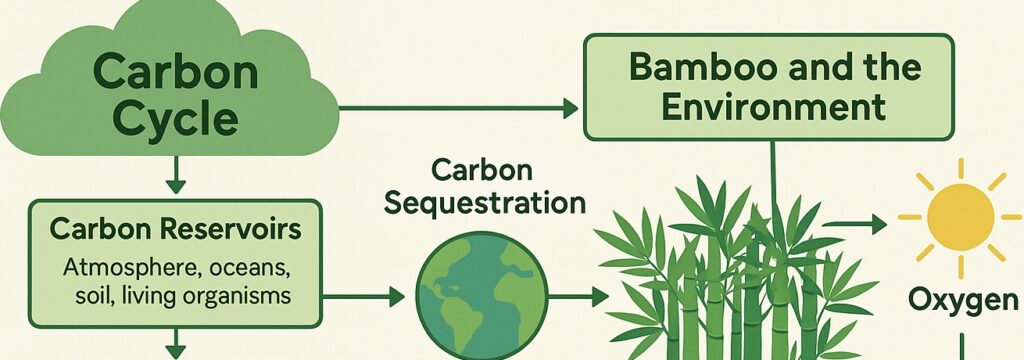
🌱 Carbon Cycle and the Role of Bamboo in the Environment 🌱
“Explore how the natural carbon cycle, bamboo energy, and biomass pellets contribute to a greener future. Learn how sustainable bamboo cultivation supports carbon sequestration, renewable energy, and environmental restoration for a cleaner, healthier planet.”
1. Understanding the Carbon Cycle
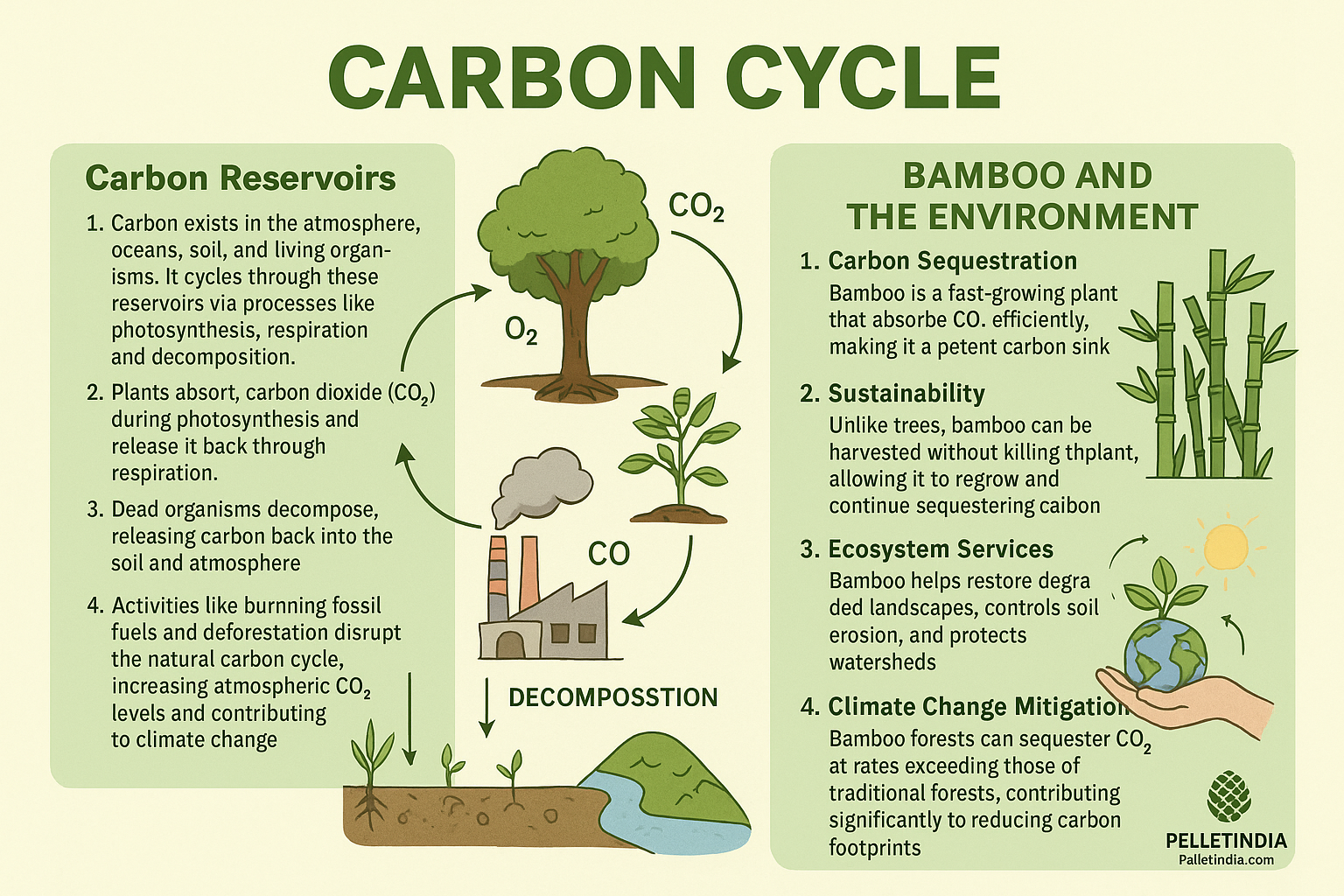
The Carbon Cycle is the natural process through which carbon moves among the atmosphere, oceans, soil, plants, and animals. It keeps Earth’s climate and life-support systems balanced.
| Step | Process | Details |
| 1. | Carbon Reservoirs | Carbon exists in the air (as CO₂), oceans (as dissolved CO₂), soils (as organic carbon), and living organisms (as biomass). |
| 2. | Photosynthesis | Plants absorb CO₂ from the atmosphere and convert it into glucose and oxygen. |
| 3. | Respiration | Plants, animals, and microbes release CO₂ back into the air during metabolism. |
| 4. | Decomposition | Dead organisms decompose, returning carbon to the soil and air. |
| 5. | Human Impact | Burning fossil fuels, deforestation, and industrial activities add massive CO₂, causing global warming. |
🔥 Current Human Impact on the Carbon Cycle:
- Global CO₂ emissions: ~36 billion tonnes per year.
- Global forest loss: ~10 million hectares per year.
- Result: Atmospheric CO₂ concentration has risen from 280 ppm (pre-industrial) to >420 ppm (today).
2. 🌿 Bamboo and the Environment
Bamboo is emerging as a powerful natural ally to restore balance.
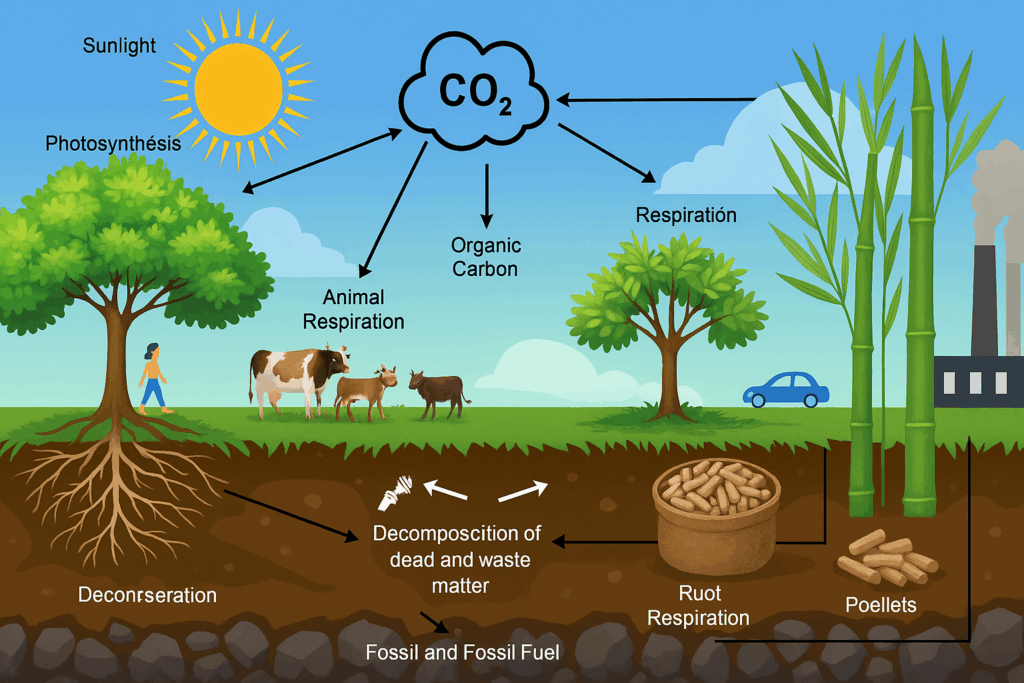
| Property | Description |
| Carbon Sequestration | Bamboo can capture up to 12 tonnes of CO₂ per hectare per year. Mature bamboo forests can store up to 200 tonnes of carbon per hectare. |
| Rapid Growth | Bamboo grows up to 1 meter per day — among the fastest-growing plants on Earth! |
| Regenerative Harvesting | Cutting bamboo does not kill the plant — it regrows from the same root system. |
| Erosion Control & Ecosystem Services | Bamboo roots bind soil, preventing erosion, restoring degraded land, and preserving watersheds. |
| Climate Change Mitigation | Bamboo forests sequester carbon 30-40% faster than many tree forests. |
| Energy Source | Bamboo biomass can be used for making pellets, biochar, biogas, or even bioethanol — sustainable energy alternatives. |
3. 🌍 How Bamboo Can Save the Earth
Here’s a detailed breakdown of how bamboo contributes:
| Action | Environmental Benefit |
| Absorbing CO₂ | Reduces greenhouse gases, slowing global warming. |
| Releasing Oxygen | Bamboo produces 35% more oxygen compared to equivalent tree mass. |
| Preventing Soil Loss | Strengthens soils, halting desertification and flooding. |
| Energy Production | Bamboo biomass energy reduces reliance on fossil fuels. |
| Supporting Biodiversity | Provides habitat for many species, enhancing ecosystems. |
| Economic Sustainability | Bamboo farming creates green jobs and rural development without destroying forests. |
🌟 Bamboo = Carbon Capture + Oxygen Factory + Renewable Energy + Land Restoration
4. 🏞️ Balance of Oxygen Increase and Green Climate Creation
➡️ 1 Hectare Bamboo Forest (approx. 10,000 m²) provides:
- Carbon Sequestration: 12–15 tonnes of CO₂ absorbed annually.
- Oxygen Production: Enough O₂ for around 25–30 people per year.
- Energy Potential:
- 5–8 tons of dry bamboo can be harvested yearly.
- Converted to biomass pellets = clean energy.
- 1 ton bamboo pellets ≈ 4.2 MWh of energy.
🌱 Resulting Environmental Balance:
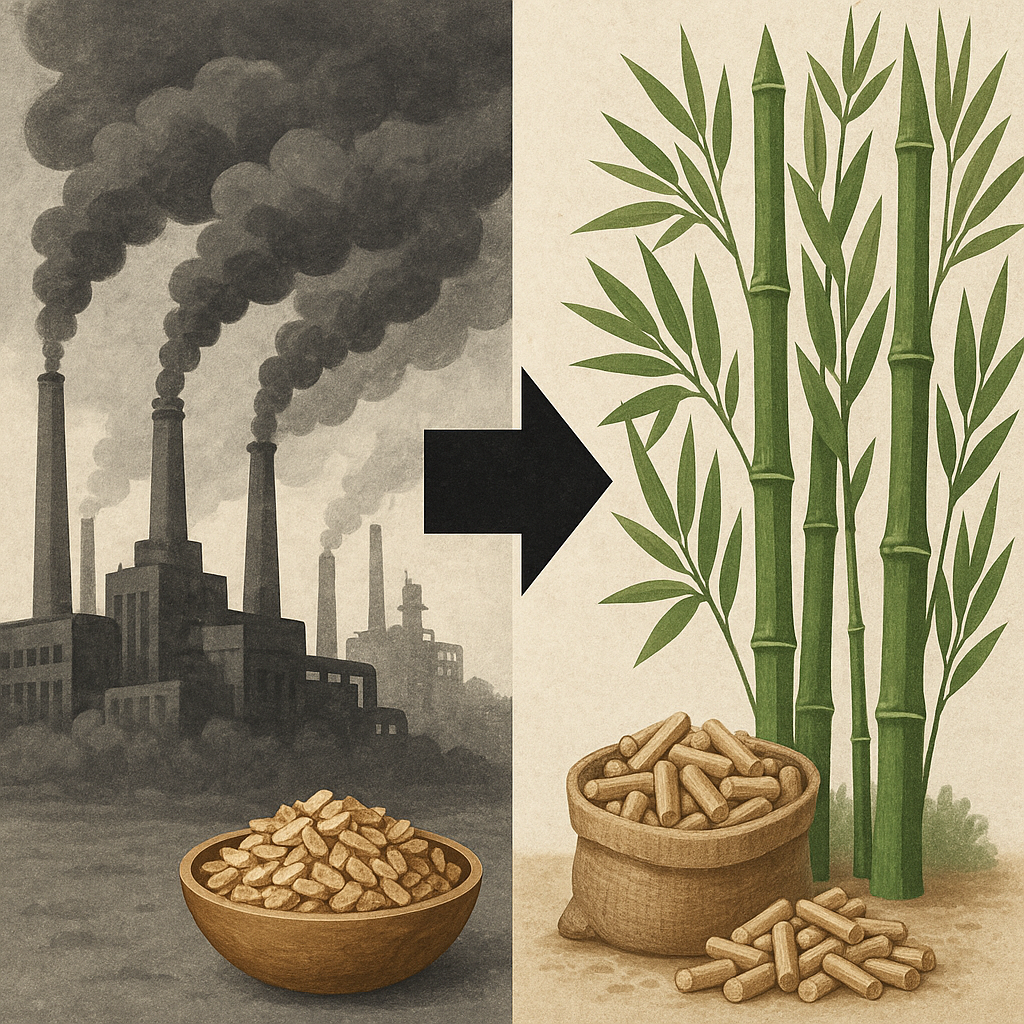
| Benefit | Impact |
| Reduced CO₂ | Direct climate change mitigation. |
| Increased O₂ | Healthier, breathable air for humans and animals. |
| Renewable Energy | Less fossil fuel usage, further reducing CO₂ emissions. |
| Land Restoration | Restores degraded ecosystems. |
✅ Yes, it creates a real, tangible balance:
More oxygen, less carbon dioxide, renewable energy — all while preserving biodiversity.
5. 📈 Figures: What If We Scale Bamboo Globally?
- Planting 1 billion hectares with bamboo (approx. available degraded land worldwide) could:
- Sequester up to 12 billion tonnes of CO₂ per year (≈ 1/3 of global CO₂ emissions!).
- Produce enough clean energy to replace 10–15% of global coal use.
- Increase atmospheric oxygen globally by up to 2–3% over decades.
- Create over 100 million sustainable jobs in green economies.
🌟 Conclusion:
✅ Bamboo offers a triple benefit:
- Climate Change Fighter (carbon sink + oxygen producer)
- Sustainable Energy Source (biomass, biochar, biogas)
- Environmental Restorer (soil, water, biodiversity)
By encouraging large-scale bamboo plantations alongside smart sustainable harvesting, humanity can save the planet, restore green landscapes, breathe cleaner air, and generate clean energy — all in harmony with nature. 🌎🎋
🌍 Balance or Burn: The Future We Choose

Left Side:
- Biomass pellets represent clean, renewable bamboo energy.
- Green, healthy Earth with balanced carbon cycle and sustainable practices.
- Symbolizes hope, restoration, and climate protection.
Right Side:
- Fossil fuels, smoke, fire, and a burning skull represent unchecked pollution.
- Carbon cycle imbalance causing extreme global warming, disaster, and destruction.
- Symbolizes the environmental collapse if no action is taken.
Meaning:
“We are at a crossroads. Choose renewable energy and bamboo-based solutions to save the planet – or face the fiery consequences of climate inaction.”


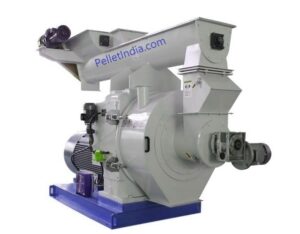
📞 Contact Us for Biomass Solutions
📍 Servoday Plants & Equipments Limited
📞 +91 9427210483 | +91 9427210484
📧 [email protected]
🌐 www.PelletIndia.com
👤 Contact Person: Sanjay Masuria
📲 WhatsApp: +91 9427210483
From Concept to Commissioning. We are with You.
Our policy is simple and transparent:
No undersized parts, no fraud, no fake components—genuinely serving since 1969. 🚀🔥
🇮🇳 India’s Progress on Reducing its Environmental Footprint 🌱
1. Renewable Energy Expansion:
India is now the world’s 3rd largest producer of renewable energy.
- Target: 500 GW of renewable capacity by 2030.
- Solar, wind, biomass, and hydropower are scaling rapidly.
2. Solar Energy Growth:
- World’s biggest solar parks (like Bhadla Solar Park in Rajasthan).
- Launch of International Solar Alliance (ISA) to unite countries for solar energy.
3. Bioenergy and Biomass Focus:
- India promotes bamboo, agri-residue, and biomass pellets to replace fossil fuels.
- Sustainable biomass projects are powering industries and rural electrification.
4. Afforestation Drives:
- Campaigns like Green India Mission planting millions of trees.
- Bamboo plantation is also rising to act as a carbon sink.
5. Electric Vehicles (EV) Push:
- Incentives for EVs to reduce oil imports and cut urban air pollution.
- Goal: 30% of all vehicles electric by 2030.
6. Waste to Energy Projects:
- Big cities converting waste into bio-CNG, compost, and electricity.
7. Climate Commitments:
- India committed at COP26 to become Net Zero by 2070.
- Carbon intensity of the economy will be reduced by 45% by 2030 (compared to 2005 levels).
8. Bamboo as a Strategic Green Material:
- Bamboo is being pushed as a renewable building material, biofuel, and climate resilience tool.
🌍 Why it Matters:
By switching to biomass, bamboo energy, and sustainable practices, India is shaping a greener, cleaner, and more self-reliant future.
Choosing Green Energy with PelletIndia supports this national and global transformation.
Disclaimer:
“This blog is for informational purposes only. Readers should verify facts independently and seek expert advice before making decisions. The blogger is not liable for any outcomes based on this content.”